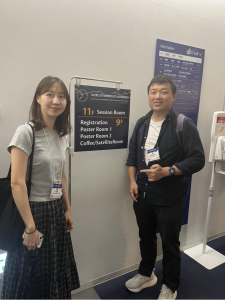An SSA student and early-career member attended a seismology-advancing conference in Kochi, Japan—an experience made possible by donor generosity.
1 November 2025— Baoning Wu never met the late seismologist who inspired SSA’s newest support program, but he knows his research well. One of Paul Spudich’s widely-cited papers is referenced throughout Wu’s PhD project on earthquake high-frequency radiation. In 2019, the project served as Wu’s first major oral presentation. He was too nervous to absorb much of the other talks that day, but he remembers why one presentation drew more applause than the rest.

“It was an ovation for Paul Spudich,” Wu says, explaining that the beloved scientist had died just a few months before the meeting, so his colleague Antonella Cirella presented Spudich’s final paper (on modeling ground motions of the 2009 L’Aquila earthquake) on his behalf.
Today SSA’s Paul Andrew Spudich Fund continues to honor the giant in seismology by providing grants that support burgeoning studies in earthquake source physics or ground motion prediction—areas Spudich made important contributions to during his distinguished career with the U.S. Geological Survey.
The fund just enabled Wu, an early-career theoretical geophysicist, and Jeena Yun, a PhD candidate at Scripps Institution of Oceanography, to participate in the September 2025 International Joint Workshop on Slow-to-Fast Earthquakes in Kochi, Japan. Both SSA members returned from the workshop with new connections, ideas and enthusiasm for their future projects.

Because Wu has worked on modeling slow earthquakes since his PhD, traveling to Japan to attend this leading conference for sharing slow-earthquake research had been on his scientific wish list for a long time. He found it especially meaningful to finally meet the slow-earthquake community in person, including scientists who have had a major impact on his work. “My abstract was selected for an oral presentation, and I gave a talk in front of Professor Ryosuke Ando, whose work my research is based on. Professor Satoshi Ide, whose ideas inspired my research, also sat in the front row,” Wu says.
Yun was eager to attend the workshop because her recent research project focuses on understanding how an earthquake can affect the sequences of slow and fast earthquakes on a nearby megathrust interface. She appreciated the workshop’s balance of contributions from different subdisciplines of geosciences, including seismology, geodesy, mineral physics and petrology, and says the experience opened her eyes to both new projects and perspectives.
“I extended my knowledge on cutting-edge research on not only slow and fast earthquakes in various subduction zones, but also their structural and geological properties,” she says, adding that she also built connections with possible collaborators from Japan, China and Canada working on different aspects of subduction zone earthquakes.

Both researchers say their career-advancing experience was only possible because of the donor-funded grant program. “Without the support of the SSA Paul Andrew Spudich Travel Grant, I would not be able to attend this workshop due to the shortage of other funding,” Yun says.
Wu feels particularly grateful for the travel grant’s focus on theoretical research. “While I don’t have tenure and probably won’t have one in the foreseeable future, I often have to work on several observational or practical projects simultaneously to support myself in conducting those with more theoretical flavor,” he says. “The SSA Paul Spudich Travel Grant offered great help to me, and I feel truly grateful.”
After receiving feedback at the workshop, Wu feels more prepared to wrap up his slow-earthquake models into publications. Yun has new contacts she can call on for projects aimed at advancing earthquake science and lowering seismic hazard.
The Paul Andrew Spudich Travel Grant program will welcome applications once again in February. “In this era of uncertain funding situations,” Yun says, “I highly encourage my peers to apply and grab this invaluable opportunity.”
To help more promising scientists like Wu and Yun advance the study of earthquake source physics and ground motion prediction, please consider making a year-end gift to the Paul Andrew Spudich Fund.
